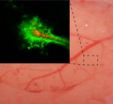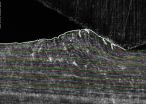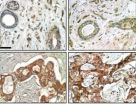(Press-News.org) WEST LAFAYETTE, Ind. - The world continues to be a noisy place, and Purdue University researchers have found that all that background chatter causes the ears of those with hearing impairments to work differently.
"When immersed in the noise, the neurons of the inner ear must work harder because they are spread too thin," said Kenneth S. Henry, a postdoctoral researcher in Purdue's Department of Speech, Language and Hearing Sciences. "It's comparable to turning on a dozen television screens and asking someone to focus on one program. The result can be fuzzy because these neurons get distracted by other information."
The findings, by Henry and Michael G. Heinz, an associate professor of speech, language and hearing sciences, are published as a Brief Communication in Nature Neuroscience. The work was funded by the National Institutes of Health and the National Institute on Deafness and Other Communication Disorders.
"Previous studies on how the inner ear processes sound have failed to find connections between hearing impairment and degraded temporal coding in auditory nerve fibers, which transmit messages from the inner ear to the brain," said Heinz, who studies auditory neuroscience. "The difference is that such earlier studies were done in quiet environments, but when the same tests are conducted in a noisy environment, there is a physical difference in how auditory nerve fibers respond to sound."
Hearing loss, suffered in varying degrees by 36 million American adults, means there is damage to sensory cells in the cochlea and to cochlear neurons as well. The cochlea is the part of the inner ear that transforms sound into electrical messages to the brain.
In this study, the researchers measured a variety of physiological markers in chinchillas, some with normal hearing and others with a cochlear hearing loss, as they listened to tones in quiet and noisy environments. Chinchillas are used because they have a similar hearing range to humans, and background noise is used in the study to simulate what people would hear in a crowded room.
"The study confirmed that there is essentially no change, even for those with hearing loss, in terms of how the cochlear neurons are processing the tones in quiet, but once noise was added, we did observe a diminished coding of the temporal structure," Henry said.
The researchers focused on coding of the temporal fine structure of sound, which involves synchrony of neural discharges to relatively fast fluctuations in sound pressure. Both coding of fast fine structure information and coding of slower envelope fluctuations are critical to perception of speech in everyday listening environments.
"When noise was part of the study, there was a reduction in how synchronized the neurons were with the temporal fine structure," Henry said.
The auditory system filters sound into a number of channels that are tuned to different frequencies, and those channels vary based on their frequency tuning. In a normal system, the channels are sharp and focused, but they get broader and more scattered with hearing impairment.
"Now that we know a major physiological effect from hearing loss is that the auditory nerve fibers are particularly distracted by background noise, this has implications for research and clinical settings," said Heinz, who also has a joint appointment in biomedical engineering. "For example, most audiology testing, whether it is lab research or hearing-loss screenings, takes place in a quiet environment, but testing noisy, more realistic backgrounds is necessary to truly understand how the ear is processing sound. This also could influence the design of hearing aids and assistive technologies.
"Designers are often working on improving the temporal coding of the signal, but this research suggests that a primary focus should be on improving noise-reduction algorithms so the hearing aid provides a clean signal to the auditory nerve. Other ways people can reduce background noise include induction-loop hearing systems, which are used in churches and other public settings to provide a cleaner signal by avoiding room noise."
Next, the researchers plan to expand the study to focus on more real-world noises and coding of slower envelope information in sound.
"Additional study is certainly needed, and there are others who are also looking at the role the central nervous system plays, too," Henry said. "But ultimately, we found that hearing loss degrades temporal coding of sounds in background noise in the cochlea, the most peripheral level of auditory processing."
INFORMATION:
Writer: Amy Patterson Neubert, 765-494-9723, apatterson@purdue.edu
Sources: Kenneth S. Henry, kshenry@purdue.edu
Michael G. Heinz, 765-496-6627, mheinz@purdue.edu
Note to Journalists: Journalists interested in a copy of the journal article can contact Amy Patterson Neubert, Purdue News Service, at 765-494-9723, apatterson@purdue.edu.
ABSTRACT
Diminished Temporal Coding with Sensorineural Hearing Loss
Emerges in Background Noise
Kenneth S. Henry & Michael G. Heinz
Behavioral studies in humans suggest that sensorineural hearing loss (SNHL) decreases sensitivity to the temporal structure of sound, but neurophysiological studies in mammals provide little evidence for diminished temporal coding. We found that SNHL in chinchillas degraded peripheral temporal coding in background noise substantially more than in quiet. These results resolve discrepancies between previous studies and help to explain why perceptual difficulties in hearing-impaired listeners often emerge in noisy situations.
Hearing impaired ears hear differently in noisy environments
2012-09-12
ELSE PRESS RELEASES FROM THIS DATE:
Planets can form in the galactic center
2012-09-12
At first glance, the center of the Milky Way seems like a very inhospitable place to try to form a planet. Stars crowd each other as they whiz through space like cars on a rush-hour freeway. Supernova explosions blast out shock waves and bathe the region in intense radiation. Powerful gravitational forces from a supermassive black hole twist and warp the fabric of space itself.
Yet new research by astronomers at the Harvard-Smithsonian Center for Astrophysics shows that planets still can form in this cosmic maelstrom. For proof, they point to the recent discovery of a ...
Improved nanoparticles deliver drugs into brain
2012-09-12
The brain is a notoriously difficult organ to treat, but Johns Hopkins researchers report they are one step closer to having a drug-delivery system flexible enough to overcome some key challenges posed by brain cancer and perhaps other maladies affecting that organ.
In a report published online on August 29 in Science Translational Medicine, the Johns Hopkins team says its bioengineers have designed nanoparticles that can safely and predictably infiltrate deep into the brain when tested in rodent and human tissue.
"We are pleased to have found a way to prevent drug-embedded ...
Newly discovered letters and translated German ode expand Texas link to infamous Bone Wars
2012-09-12
In the late 1800s, a flurry of fossil speculation across the American West escalated into a high-profile national feud called the Bone Wars.
Drawn into the spectacle were two scientists from the Lone Star State: geologist Robert T. Hill, now acclaimed as the Father of Texas Geology, and naturalist Jacob Boll, who made many of the state's earliest fossil discoveries.
Hill and Boll had supporting roles in the Bone Wars through their work for one of the feud's antagonists, Edward Drinker Cope. A new study by vertebrate paleontologist Louis L. Jacobs at Southern Methodist ...
Scripps Research scientists devise powerful new method for finding therapeutic antibodies
2012-09-12
LA JOLLA, CA, September 11, 2012 – Scientists at The Scripps Research Institute have found a new technique that should greatly speed the discovery of medically and scientifically useful antibodies, immune system proteins that detect and destroy invaders such as bacteria and viruses. New methods to discover antibodies are important because antibodies make up the fastest growing sector of human therapeutics; it is estimated that by 2014 the top-three selling drugs worldwide will be antibodies.
The new technique, described in an article this week published online ahead of ...
Ageism presents dilemmas for policymakers worldwide
2012-09-12
The negative consequences of age discrimination in many countries are more widespread than discrimination due to race or gender, yet differential treatment based on a person's age is often seen as more acceptable and even desirable, according to the newest edition of the Public Policy & Aging Report (PP&AR). This publication, which features cross-national perspectives, was jointly produced by The Gerontological Society of America (GSA) and AGE UK.
The PP&AR explores how discriminatory behaviors manifest themselves, steps that are being taken to address those behaviors, ...
Sliding metals show fluidlike behavior, new clues to wear
2012-09-12
"We see phenomena normally associated with fluids, not solids," said Srinivasan Chandrasekar, a professor of industrial engineering at Purdue University, working with postdoctoral research associates Narayan Sundaram and Yang Guo.
Numerous mechanical parts, from bearings to engine pistons, undergo such sliding.
"It has been known that little pieces of metal peel off from sliding surfaces," Chandrasekar said. "The conventional view is that this requires many cycles of rubbing, but what we are saying is that when you have surface folding you don't need too many cycles for ...
NASA's Global Hawk investigating Atlantic Tropical Depression 14
2012-09-12
NASA's Hurricane and Severe Storm Sentinel (HS3) airborne mission sent an unmanned Global Hawk aircraft this morning to study newborn Tropical Depression 14 in the central Atlantic Ocean that seems primed for further development. The Global Hawk left NASA's Wallops Flight Facility on Wallops Island, Va., this morning for a planned 26-hour flight to investigate the depression.
NASA's latest hurricane science field campaign began on Sept. 7 when the Global Hawk flew over Hurricane Leslie in the Atlantic Ocean. HS3 marks the first time NASA is flying Global Hawks from the ...
Scrub jays react to their dead
2012-09-12
Western scrub jays summon others to screech over the body of a dead jay, according to new research from the University of California, Davis. The birds' cacophonous "funerals" can last for up to half an hour.
Anecdotal reports have suggested that other animals, including elephants, chimpanzees and birds in the crow family, react to dead of their species, said Teresa Iglesias, the UC Davis graduate student who carried out the work. But few experimental studies have explored this behavior.
The new research by Iglesias and her colleagues appears in the Aug. 27 issue of ...
Protein linked to therapy resistance in breast cancer
2012-09-12
A gene that may possibly belong to an entire new family of oncogenes has been linked by researchers with the U.S. Department of Energy (DOE)'s Lawrence Berkeley National Laboratory (Berkeley Lab) to the resistance of breast cancer to a well-regarded and widely used cancer therapy.
One of the world's leading breast cancer researchers, Mina Bissell, Distinguished Scientist with Berkeley Lab's Life Sciences Division, led a study in which a protein known as FAM83A was linked to resistance to the cancer drugs known as EGFR-TKIs (Epidermal Growth Factor Receptor-Tyrosine Kinase ...
What are the effects of the Great Recession on local governments?
2012-09-12
Freezing positions and cutting workforces
Trimming pension and health care costs and passing them to employees
Lowering service delivery levels, but not imposing many new fees
Using technology to reduce costs where possible
Receiving added pressure but little help from States and the Federal Government
This important new research sheds light on the challenges faced by city and county governments that must provide most basic services. Unlike federal or state governments, these local governments have limited ability to generate revenue and are often mandated to pay for ...








